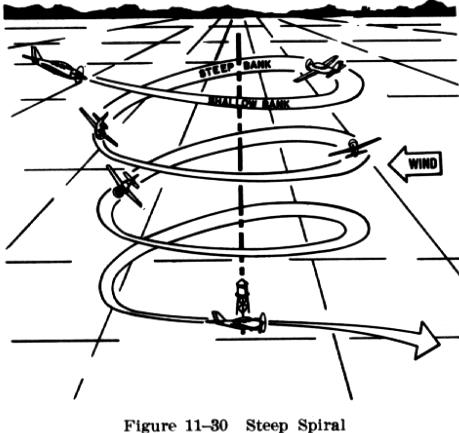Steep Spirals
Steep Spirals
A "steep spiral" is nothing more than a continuous gliding
turn, during which a constant radius around a point on the ground is maintained
similar to the maneuver "turns around a point." The radius should be such
that the steepest bank will be approximately 50 to 55 degrees. The objective
of the maneuver is to improve pilot techniques for power off turns, wind
drift control, planning, orientation, and division of attention. This spiral
is not only a valuable flight training maneuver, but it has practical application
in providing a procedure for dissipating altitude while remaining over
a selected spot in preparation for landing, especially for emergency forced
landings.
| Sufficient altitude must be obtained before starting this
maneuver so that the spiral may be continued through a series of at least
three 360 degree turns (Fig. 11-30). However, the maneuver should not be
continued below a minimum safe altitude.
Operating the engine at idle speed for a prolonged period
during the glide may result in excessive engine cooling or spark plug fouling.
Therefore, the engine should be cleared periodically be briefly advancing
the throttle to normal cruise power, while adjusting the pitch attitude
to maintain a constant airspeed. Preferably, this should be done while
headed into the wind to minimize any variation in groundspeed and radius
of turn.
After the throttle is closed and gliding speed is established,
a gliding spiral should be started and a turn of constant radius maintained
around the selected spot on the ground. This will require correction for
wind drift by steepening the bank on downwind headings and shallowing the
bank on upwind headings, just as in the maneuver "turns around a |
|
point." During the descending spiral the pilot must judge the direction
and speed of the wind at different altitudes and make appropriate changes
in the angle of bank to maintain a uniform radius.
A constant airspeed should also be maintained throughout
the maneuver. Failure to hold the airspeed constant will cause the radius
of turn and necessary angle of bank to vary excessively. On the downwind
side of the maneuver, the steeper the bank angle the lower the pitch attitude
must be to maintain a given airspeed. Conversely, on the upwind side, as
the bank angle becomes shallower, the pitch attitude must be raised to
maintain the proper airspeed. This is necessary because the airspeed tends
to change as the bank is changed from shallow to steep to shallow.
During practice of the maneuver the pilot should execute
a specific number of turns and roll out toward a definite object or on
a specific heading. During the rollout, smoothness is essential, and the
use of controls must be so coordinated that no increase or decrease of
speed results when the straight glide is resumed.
